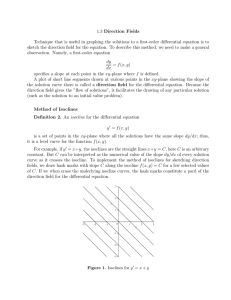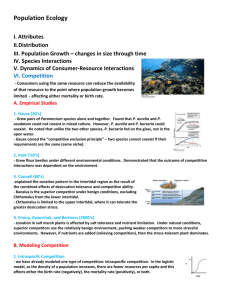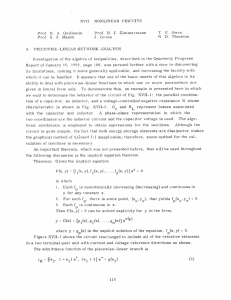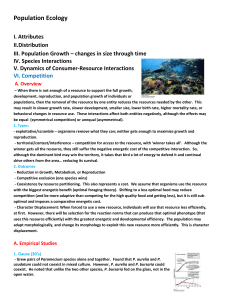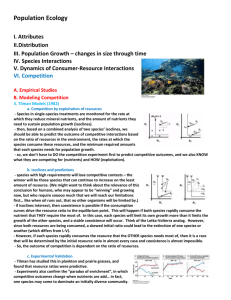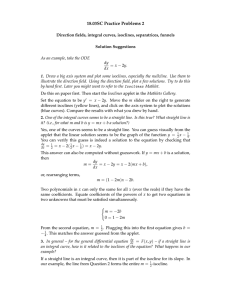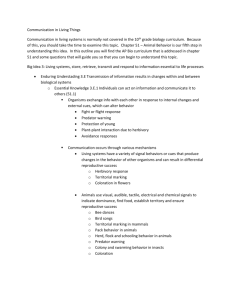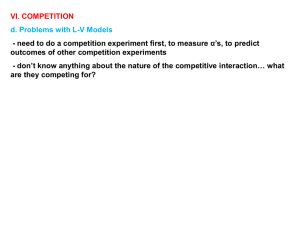In the Lotka-Volterra competitoin equation dN1/dt = rN1 ((K1-N1
advertisement
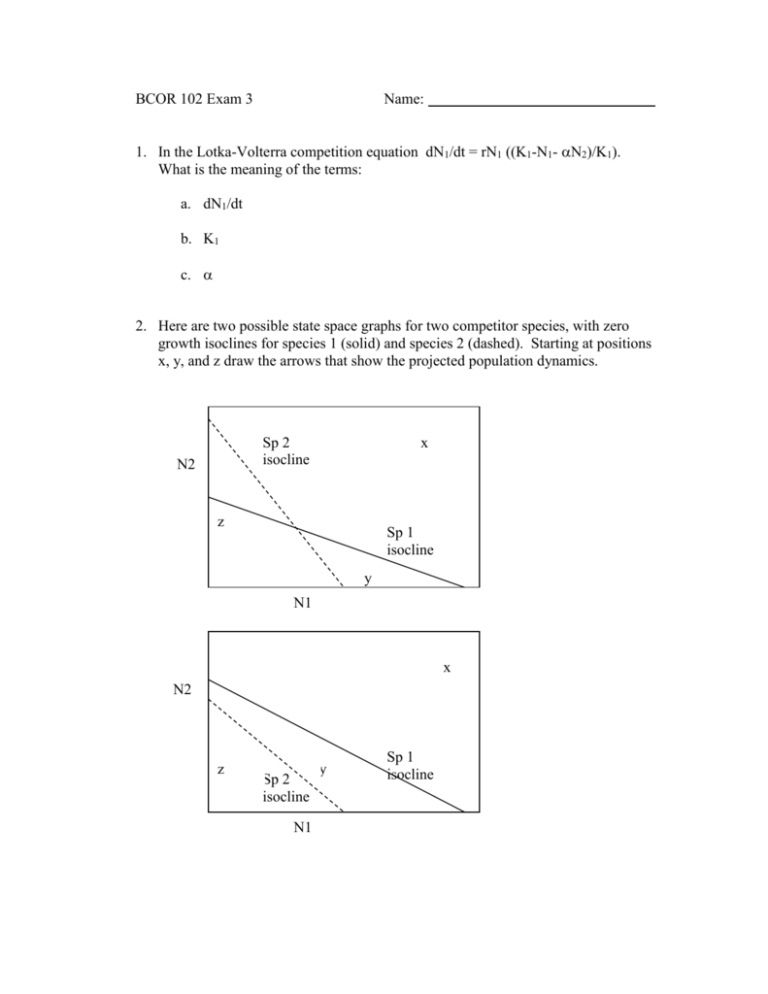
BCOR 102 Exam 3 Name: 1. In the Lotka-Volterra competition equation dN1/dt = rN1 ((K1-N1- N2)/K1). What is the meaning of the terms: a. dN1/dt b. K1 c. 2. Here are two possible state space graphs for two competitor species, with zero growth isoclines for species 1 (solid) and species 2 (dashed). Starting at positions x, y, and z draw the arrows that show the projected population dynamics. Sp 2 isocline N2 x z Sp 1 isocline y N1 x N2 z Sp 2 isocline N1 y Sp 1 isocline 3. The basic predator-prey model uses the following system of equations for predators and victims: dV/dt = rV – VP dP/dt = VP – qP Assume you have measured the following parameters: the intrinsic growth rate (r) of the victim population is 0.30; the intrinsic death rate of the predator is q=0.20; = 0.005 = 0.008 Number of Predators a. Draw the zero growth 100 isoclines for the predator 80 and victim (be sure to label 60 which is which!). i. 40 b. If the abundance of 20 the predator and victim 0 populations start at the 0 50 100 150 200 point shown on Number of Victims the graph, draw an arrow showing the initial changes in the population sizes. 4. The marginal value theorem (see graph) is used to predict the optimal time a forager should spend in a patch. a. Label the axes. b. Now imagine that it is a good year and the average B density of patches increases. How does that change the graph? c. Should the forager spend more or less time in a patch? Why A C 5. The MacArthur-Wilson theory of island biogeography is often depicted in graphical form, like this: a. Label the axes b. Label the immigration and extinction curve c. Now modify the immigration curve to that of a more distant island? d. How does that change the equilibrium number of species? 6. Bluegill sunfish have a choice of several possible food items, with the following energy values and search times. Which items should be included in their diet and which should be excluded if the bluegills are foraging optimally? Prey Type Search Time si (sec) Handling Time hi, (sec) Energy per Prey Ei (kJ) Profitability Ei/hi A 30 10 8 0.8 Value of continued searching Ei/(hi+si) 0.2 B 10 2 2 1 0.166 C 4 4 2 0.5 0.25 D 10 10 12 1.2 0.6 Include in Diet? (Y/N) 7. In New England forests, tree species compete primarily for light. Imagine that an ecologist made these measurements on the trees. a. Which column corresponds to R*? b. Which species will be the competitive dominant(s)? Species Minimum Light for growth (umol) Beech 2 Hemlock 3 Sugar Maple 7 Red Maple 15 Red Oak 20 Yellow Birch 6 White Birch 45 Maximum growth rate (mm/yr) 5 3 7 12 15 8 18 Mortality rate (trees/yr) 0.001 0.003 0.001 0.025 0.022 0.018 0.033 8. Lawns are near monocultures, in part because grass is a good competitor. It will outcompete most weeds such as dandelions etc. Nevertheless, any homeowner will tell you that dandelions and other weeds persist in their lawns. Using the principles we have learned in class, what might allow those weeds to persist in face of competition from a superior competitor (grass)? 9. This figure shows the pattern of food use for three species that have somewhat overlapping diet requiements. For each pair of species, estimate the approximate value of the competiton coefficient (): (circle one) Freq 1 2 3 Resouce Gradient 1 vs 2 2 vs 3 1 vs 3 10. Tadpoles of wood frogs and spring peepers compete for food in a pond. Assume that wood frogs are the less efficient forager: From the perspective of peepers, each wood frog reduces the food available to peepers as much as 0.75 spring peepers. From the perspective of wood frogs, each peeper is equivalent to 0.90 wood frogs. Finally, assume that both have equal carrying capacitites (K=100). Can these species coexist? 11. What is the evolutionary explanation for why males of many bird species (peacocks, mallards, cardinals, etc.) are more brightly colored than the females? (i.e. why is it always the male?) b. A few species have the opposite pattern. E.g. female jacanas and phalaropes are more brightly colored than the males. What would you predict about the mating behavior and patterns of parental care in those two species? 12. Does the “good genes” model of sexual selection require conscious choice on the part of females? Why or why not? 13. What is an “Evolutionary Stable Strategy” (ESS)? EXTRAS Draw a state-space graph (N1 vs N2) showing a situation where the two competitors can coexist. Label the axes, isoclines, K1 and K2. Bonus: For that same scenario and same parameters, draw a graph of N1 vs time, starting with K1 of species 1 and 1 of species 2. Two spp in same habitat. One is a generalist . Can’t be any difference in prey abundance (same opportunities). If foraging optimally, what difference might cause one to be a generalist? Competition give Ks, allpha and beta: can these spp coexist? Draw state space isoclines for story problem Removal expts Predation why cycles? Niche Evol something about anolis? Distribuition of food use for two sizes of anoles. Overlap. Abundance of food. Direction of selection on the small one????? Islands Succession Draw a loop diagram for the "faciliation" model (3 class: annual, perennial, trees). Make up a matrix that corresponds to your loop diagram of succession. Games: what is an ESS? Foraging Marginal value. (just like homework) Diet choice (just like homework, but real example). Sexual Selection good genes vs sexy son In a few species the males do most of the parental care. What do you expect for the Models of female choice (such as the ‘good genes’ or ‘sexy son’ models) posit different advantages for females the choose males with certain exaggerated traits. Although certain phenotypes elicit the mating reponse, there is little or no evidence that females are consciously “choosing” the mates.
